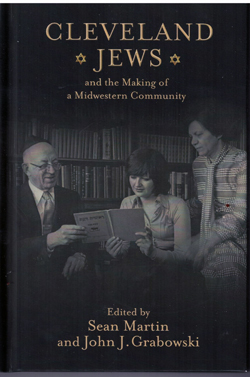Cleveland Jews and the Making of a Midwestern Community, edited by Sean Martin and John J. Grabowski; Rutgers University Press; 2020; ISBN 9781978-809949l; 242 pages including end notes and index.

 SAN DIEGO – I’ve always perceived a difference in outlook between biographers and historians. Biographers, whose works I love to read, follow an individual’s course through the world, the implicit assumption being that humans, to a large degree, can be navigators and pilots of their fates. Historians tend to look at the broader picture, focusing on how such circumstances as, say, war, depression, climate change, economic prosperity, opiate consumption, or religious observance impacted large populations of people over a given period of time. The implication is that humans do not determine their destiny; that is determined for them by factors largely beyond their control.
SAN DIEGO – I’ve always perceived a difference in outlook between biographers and historians. Biographers, whose works I love to read, follow an individual’s course through the world, the implicit assumption being that humans, to a large degree, can be navigators and pilots of their fates. Historians tend to look at the broader picture, focusing on how such circumstances as, say, war, depression, climate change, economic prosperity, opiate consumption, or religious observance impacted large populations of people over a given period of time. The implication is that humans do not determine their destiny; that is determined for them by factors largely beyond their control.
Admitting my bias here, it’s easy for me to cast a history onto my “yeah, maybe I’ll read this someday” pile of unread books, whereas once I start reading a biography, I find it very hard to put down. Many biographies are like novels, which I also enjoy; you just can’t wait to learn what the turning point was, or how it all worked out.
Cleveland Jews and the Making of a Midwestern Community contains a pair of biographical essays, which I read with considerable interest, and more than a majority of essays of the historical type, dealing with such phenomena as the growth of Jewish Orthodoxy in Cleveland; the impact of Jewish philanthropy on that city; the growth of Jewish schools; The development of feminist ideals among Jewish women’s organizations; Black-Jewish relations in Cleveland; suburbanization of Cleveland’s Jewish community; Reform Judaism in the Cleveland suburbs; and programs to assimilate into Jewish society refugees from the Soviet Union.
All those essays are informative, and if any of these areas coincide with your own interests, I will not hesitate to recommend these essays along with their voluminous footnotes. Their scholarship is undeniable.
The biographical chapters that I most enjoyed reading dealt with two interesting Clevelanders who, on the face of it, would seem to be very different, but upon deeper reflection had much in common. I am speaking in one instance about Reform Rabbi Abba Hillel Silver, who forged an alliance with U.S. Senator Robert Taft (R-Ohio), to promote the establishment of Israel. The other biographical subject is Harvey Pekar, a pioneer in the comic book world, who instead of creating escapist, super-hero literature, transformed his own everyman trials, tribulations, and grousing into graphic art classics, upon which the movie American Splendor was based. In that movie, Pekar was played by Paul Giamotti, and cartoonist Robert Crumb, who drew many of Pekar’s comic books, was portrayed by James Urbaniak.
In his later life, Pekar was known as a fierce critic of Israel, in contrast to Silver who had worked so hard to promote it. The title of one of Pekar’s comic books, Not the Israel My Parents Promised Me, explains the commonality between the two men. Rabbi Silver’s vision of a Jewish state coincided with Pekar’s disappointed expectations.
While I respect the work of the other contributors to this anthology about Jewish Cleveland, as a committed reader of biographies, I particularly would like to applaud Samantha Baskind and Zohar Segev, who were the authors of the essays about Pekar and Silver respectively.
*
Donald H. Harrison is editor of San Diego Jewish World. He may be contacted via donald.harrison@sdjewishworld.com